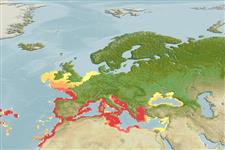Environment: milieu / climate zone / depth range / distribution range
Ecology
Marine; demersal; non-migratory; depth range ? - 800 m (Ref. 4570). Temperate; 55°N - 25°N, 32°W - 42°E
Eastern Atlantic: British Isles to the Azores, and the Canary Islands, including Morocco, the Mediterranean Sea and the Black Sea.
Length at first maturity / Size / Weight / Age
Maturity: Lm 14.4, range 10 - ? cm
Max length : 40.5 cm TL male/unsexed; (Ref. 33903); common length : 15.0 cm TL male/unsexed; (Ref. 3397); max. published weight: 870.00 g (Ref. 40637)
Dorsal spines (total): 12; Dorsal soft rays (total): 7 - 9; Anal spines: 3; Anal soft rays: 4 - 6. This species is distinguished by the following characters: D XII,7-9 with the last divided at base; pectoral fin rays 16-18, uppermost branched pectoral fin ray is usually the third (rarely second to fourth); lacrimal usually with 2 spines over maxilla that point at nearly right angle from each other, posterior pointing ventrally and slightly anteriorly; occipital pit is well-developed; anteriormost mandibular lateral line pores are widely separated; scales small, emarginate, no distinct ctenii; scale rows in longitudinal series 56-60; no scales on chest and pectoral fin base; cirri well developed over entire head and body, no cirri on lower jaw (Ref. 122805).
Cross section: compressed.
Solitary and sedentary. Common among rocks and algae. Feeds on small fishes (gobies, blennies), crustaceans and other invertebrates (Ref. 4570).
Life cycle and mating behavior
Maturity | Reproduction | Spawning | Eggs | Fecundity | Larvae
Fricke, R., D. Golani, B. Applebaum-Golani and U. Zajonz, 2018. Scorpaena decemradiata new species (Teleostei: Scorpaenidae) from the Gulf of Aqaba, northern Red Sea, a species distinct from Scorpaena porcus. Scientia Marina 82(3):1-16. (Ref. 122805)
IUCN Red List Status (Ref. 130435: Version 2024-2)
Threat to humans
Traumatogenic (Ref. 4690)
Human uses
Fisheries: minor commercial; aquarium: commercial
Tools
Special reports
Download XML
Internet sources
Estimates based on models
Preferred temperature (Ref.
123201): 11.2 - 15.8, mean 13.9 °C (based on 232 cells).
Phylogenetic diversity index (Ref.
82804): PD
50 = 0.5000 [Uniqueness, from 0.5 = low to 2.0 = high].
Bayesian length-weight: a=0.01349 (0.01199 - 0.01518), b=3.02 (2.99 - 3.05), in cm total length, based on LWR estimates for this species (Ref.
93245).
Trophic level (Ref.
69278): 3.9 ±0.2 se; based on diet studies.
Generation time: 6.4 (6.0 - 10.3) years. Estimated as median ln(3)/K based on 10
growth studies.
Resilience (Ref.
120179): Medium, minimum population doubling time 1.4 - 4.4 years (K=0.2-0.5; tmax=8).
Fishing Vulnerability (Ref.
59153): Moderate to high vulnerability (47 of 100).
🛈
Climate Vulnerability (Ref.
125649): Moderate vulnerability (38 of 100).
🛈
Nutrients (Ref.
124155): Calcium = 34.5 [19.3, 77.6] mg/100g; Iron = 0.359 [0.197, 0.663] mg/100g; Protein = 18.1 [16.6, 19.6] %; Omega3 = 1.09 [0.49, 3.04] g/100g; Selenium = 19.6 [10.1, 44.7] μg/100g; VitaminA = 17.9 [5.5, 53.9] μg/100g; Zinc = 0.525 [0.377, 0.761] mg/100g (wet weight); based on
nutrient studies.
